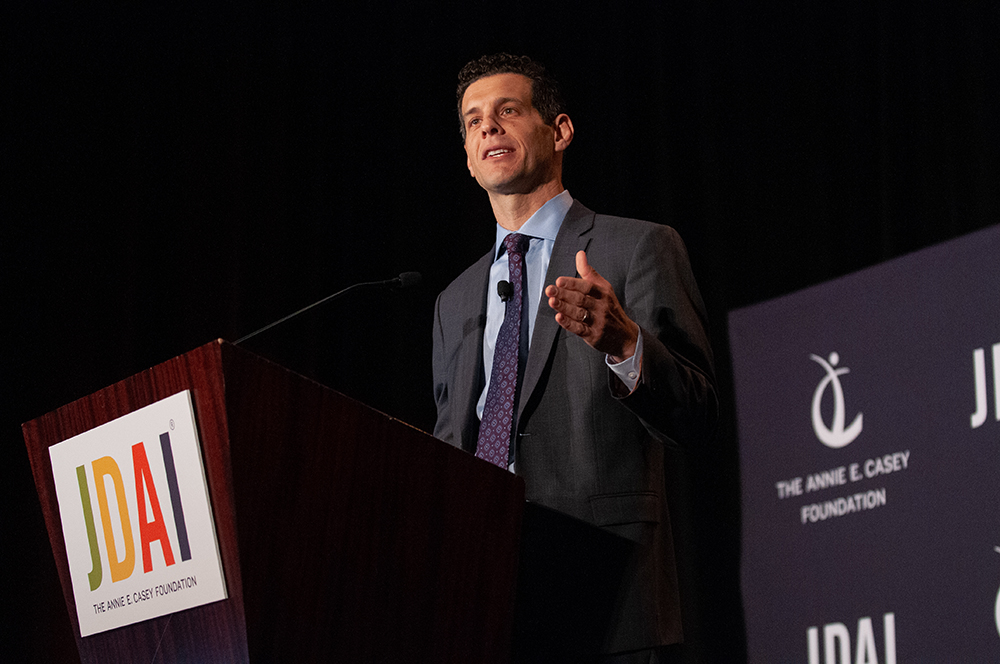SEATTLE — When the Annie E. Casey Foundation launched the Juvenile Detention Alternatives Initiative (JDAI) in the tough-on-crime era of the early 1990s, politicians were labeling teenage offenders “superpredators” and states were passing laws making it easier to prosecute kids as adults. Rates of juvenile detention were skyrocketing.
Nearly 30 years later, JDAI’s radical-for-its-time proposition that locking youth up neither improves their behavior nor protects public safety has been borne out.
Average daily juvenile detention populations have been halved in the more than 300 counties across 40 states and Washington, D.C., that have adopted JDAI reforms. Detention admissions are down 57%. In most localities, crime rates have continued to decline.
Today, “JDAI no longer devotes all, or even most, of its energy to detention reform,” Nate Balis, director of Casey’s Juvenile Justice Strategy Group, told the 800 attendees at JDAI’s annual conference last week in Seattle.
So what’s next for JDAI and juvenile justice reform?
For more information on Racial-Ethnic Fairness, go to JJIE Resource Hub | Racial-Ethnic Fairness
Overhauling probation, tackling the persistent over-representation of youth of color and increasing diversion are key areas for deeper reform, Balis said.
Given the mounting evidence of detention’s harmful impacts on youth, it’s also “time for all JDAI sites to ... rethink their purpose of detention,” he said. “The onus is now on us to justify why any young person should be locked up.”
Transforming juvenile probation
In the U.S., “we give probation to everyone,” Balis told the crowd. More than 60% of adjudicated youth receive probation, including many with first-time misdemeanors, according to a 2018 Casey report. Conventional probation doesn’t work, he said, “and it is actually harmful for youth at low risk for rearrest.”
For that reason, Casey has begun working with jurisdictions to reduce the number of youth placed on probation and to move away from the traditional compliance-based model to one focused more on incentives and positive youth development.
Pierce County, Wash., which includes the city of Tacoma, is one of two sites that received a Casey probation transformation grant in 2014. There, a new program called Opportunity-Based Probation incentivizes positive behavior by allowing youths to earn prizes such as gift cards, opportunities to participate in internships and other activities, and even to exit probation early.
The county worked for a year with University of Washington researchers to develop a new probation model that reflects the science of adolescent brain development, said TJ Bohl, the Juvenile Court administrator. "It changes the whole way we engage families and view court and court orders,” he said in an interview. “I'm very proud of that."
Implemented about two years ago, the program is still being evaluated, but it “has been having great success with youth of color,” Bohl said.
The court is continuing to expand community partnerships that provide job training and other positive connections for youth. “So that way when probation is over, it’s not like a void,” Bohl said. “They have something to do, they have something that they feel good about.”

Chiaki Kawajiri for the Annie E. Casey Foundation
Nate Balis spoke at the JDAI conference in Seattle.
In Lucas County, Ohio, also a Casey probation transformation grant site, most of the youth getting probation were high needs but low risk, said Juvenile Court Probation Administrator Demecia Wilson at a conference workshop on shifting probation practice and culture.
So the court created Misdemeanor Services, which works with schools and community organizations to link youth and their families with services and “leave kids better off than when they came to us,” Wilson said.
Today the court has 160 young people on probation, down from more than 500. It has also cut the number of probation officers from a high of 20 to just nine.
The lower caseloads have allowed the court to work more intensively and intentionally with felony-adjudicated youths on probation, Wilson said. The court is also re-examining how it responds to the many youth who are detained for technical violations of probation conditions such as missing school.
That’s an example of transforming probation, “not just nibbling around the edges,” Steve Bishop, Casey’s senior associate of juvenile justice strategy, told the room.
“We really want to think about what’s developmentally appropriate for young people,” he said, “and what’s going to not only reduce harm, but create opportunities for them.”
Road to ‘zero youth detention’
Since the early days of JDAI, “right kid, right place, right time,” has been a motto of detention reform.
“That motto,” Balis told the audience, “has outlived its usefulness” and “kept us too comfortable with locking kids up.”
It also has been turned on its head in places like San Francisco, where the board of supervisors recently voted to close the county’s detention center. King County, Wash., where the conference was held, has adopted a plan to achieve zero youth detention.
The idea of zero youth detention “might make some of your heads spin,” Balis acknowledged. Yet he urged the audience to take its ideal to heart.
“The very formulation signals that detention should never be normal or routine,” he said. “Rather, our systems must explore every option and confine young people only in extraordinary cases.”
Pierce County’s Bohl said he shares that ambition. The county’s average daily detention population has fallen from about 150 before it joined JDAI in 2004 to 20 today. “I can envision a time when we deal with youth conduct problems in the community only,” he said.
Key steps, he said, include reallocating resources to community partners to support kids and families, using restorative justice approaches and building relationships with communities that have been marginalized for years.
It also requires shifting the narrative around kids’ behavior.
A lot of people think, “‘Oh, that kid’s out of control, he’s defiant, he needs to be taught a lesson, he needs to be put in jail,’” Bohl said. “I would challenge us to rethink that and say, ‘What happened to that kid?’”
Only then, he said, can we address kids’ trauma and help them achieve their promise.

Pingback: Next Target for Juvenile Justice Reform: Probation | Geoffrey Gardner
Pingback: Next Target for Juvenile Justice Reform: Probation - Viralia News - Reports 24H
Pingback: Next Target for Juvenile Justice Reform: Probation | The Crime Report